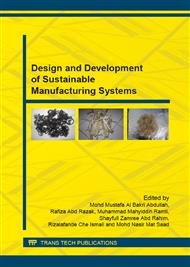p.69
p.74
p.79
p.84
p.89
p.94
p.101
p.106
p.111
Study of Covalent/Ionic Cross-Linked Modification on Physical and Mechanical Properties of Chitosan Film as Potential Material in Medical Application
Abstract:
The aim of this study was to investigate the effects of covalent and ionic cross-linked reactions which were respectively done by using genipin and tripolyphosphate (tpp), on the structure and mechanical properties of chitosan film. Both cross-linked and uncross-linked films were prepared by solution casting method and characterized. FTIR spectra showed no characteristic of –OCH3 peak from genipin at 1444 cm-1 which resulted by a new covalent bonding in chitosan film. Reduction in absorption intensity at 1560 cm-1 wave number in chitosan cross-linked tpp films were due to the presence of ionic interaction between the positive charged of amino group in chitosan and negatively charged of phosphate group by tpp. The pattern area from the XRD results showed that the covalent cross-linked had significantly changed on the chitosan`s degree of crystallinity. The water contact angle on the surface of covalent/ionic cross-linked chitosan film reached the highest θ at 82.72° which indicated more hydrophobic properties was formed. Covalent/ionic cross-linked chitosan also showed the higher mechanical strength with average tensile stress value at 71.25 MPa. All finding results demonstrated that cross-linked modification on the chitosan film had successfully reduced the film’s hydrophilicity and increased the mechanical properties of the film.
Info:
Periodical:
Pages:
89-93
Citation:
Online since:
November 2015
Keywords:
Price:
Сopyright:
© 2015 Trans Tech Publications Ltd. All Rights Reserved
Share:
Citation:


